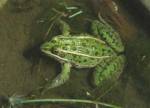    



|
|
Northern Leopard Frog
Management
 Prior to 1980, the Northern Leopard Frog was widely distributed and locally abundant over much of Alberta south of Edmonton. However, populations are now greatly reduced in number, and the range is limited mainly to the lower reaches of the South Saskatchewan and Milk River drainage basins. Prior to 1980, the Northern Leopard Frog was widely distributed and locally abundant over much of Alberta south of Edmonton. However, populations are now greatly reduced in number, and the range is limited mainly to the lower reaches of the South Saskatchewan and Milk River drainage basins.
In Alberta, the cause(s) of the abrupt and widespread population declines that occurred in the late 1970s and early 1980s remains a mystery. Our lack of understanding about causes of the declines is reason for concern. Even if populations were to recover, either naturally or through
conservation initiatives, the
species would have to be considered at risk until such time as the
causes of the decline are determined and addressed.
Recent general population increases in Saskatchewan and Manitoba provide some promise that Northern Leopard Frog populations will recover in Alberta. Natural recovery and re-establishment of populations in formerly occupied areas will be dependent of dispersal of individuals from the remaining breeding populations. We know very little, however about dispersal in Northern Leopard Frogs and it is therefore difficult to predict the extent to which dispersal may lead to recolonization of suitable
habitat areas. Re-establishment in some areas, particularly the central parkland, may therefore be dependent on transplanting individuals from the major breeding populations in southern Alberta. Until such time as broad-scale transplantation is feasible, continued surveys and monitoring of provincial populations will be necessary to ensure that current population distribution and trends in the province are well understood.
Reprinted from Alberta Wildlife Status Report No. 9
(1997),
with permission from Alberta
Sustainable Resource Development.
[Introduction][Alberta
Home][Limiting Factors][Status][Management]
|
 Heritage Community Foundation Presents
Heritage Community Foundation Presents









